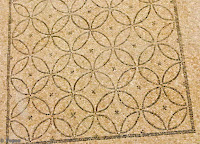Nowadays, the Fortress is a gothic square-shaped building of around 4,000 m2. Its four towers are well preserved: the tower of the Homenaje in the Northeast end, the one of the León in the Northwest and the one of the Inquisition or the Gardens in the Southeast. All them are communicated through a narrow corridor (called Camino de Ronda). This corridor runs along the wall and is protected by the merlons. The fourth tower wall called Vela or Paloma.
Inside the complex there is a rectangular Moorish courtyard whose walls are covered by stucco baseboard with original Arabic drawings.
There are also Roman baths which became afterwards the Royal Baths used by the Caliph. They are under the Salón de los Mosaicos. This room was the Chapel of the Inquisition and it was built in the XVIII century. It is called Salón de los Mosaicos because its walls are decorated with Roman mosaics and other creations of the II and III century.
These mosaics were found in the excavations of 1959 in Plaza de la Corredera, an area which was outside the fortified complex of Colonia Patricia Corduba. This mosaic represents Polifemo and Galatea.
Another mosaic represents the head of Medusa, an important Roman mythological character. It is the symbol of the strength and the power.
Another of the treasures of the Fortress is the Roman sarcophagus of the III century. It was found in the excavations of the Huerta de San Rafael del Brillante in 1958. The main engraving is the half-opened Hades' door.
Outside the Fortress is what was originally the Fortress garden, where there are gardens with an approximate extension of 55,000m2 where. The gardens has a great variety of autochton plants characteristics of an Arabic garden: orange trees, lemon trees, fountains, cypresses, ponds and palm trees.
This place captivates with its history and relaxes with its gardens allowing the visitor to remember that visit for a long time.











